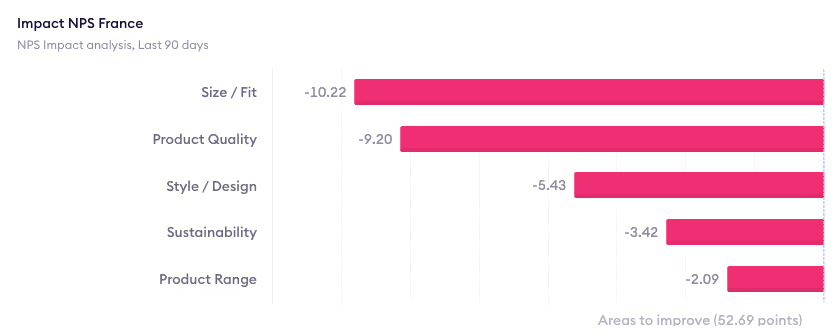Having spent a decade helping brands build exceptional customer experience, the most eye-opening thing for me has been that genuinely successful business outcomes, such as better customer retention and higher spend per customer, and ultimately long-term profitable growth, come not from fixing issues but from amplifying the critical drivers of positivity.
This is the most common mistake I see when learning from customers and likely the single most significant change you can make in your current strategy.
Why do we care about customer feedback?
Let’s start with the basics.
Why are we interested in our customers' feedback?
Why run elaborate surveys, build expensive surveys, and spend precious time trying to learn from the data?
I firmly believe the answer is to make an impact by driving our companies to long-term profitable growth through better retention, higher lifetime values, and word-of-mouth growth, not just to close a few more Jira tickets.
When appropriately used, customer feedback analysis is a source of insight you can’t find anywhere else - it allows you to find initiatives that drive customer behavior that achieve outcomes that would otherwise be impossible without astronomical Marketing or Product budgets.
And yet, the shocking truth is that many businesses miss out on the potential of customer insights by looking at just the negative feedback and getting stuck in the “discover problem >> fix problem” loop.
We call this the finder-fixer mindset. This approach seems logical.
Wouldn’t you eventually get a perfect customer experience by eliminating issues and annoyances?
Unfortunately, the answer is no, you won’t.
While you could refine your experience to be free of obvious flaws, if it is not offering anything that stands out from your competitors and does not leave a lasting positive impression on your customers, they will not have a reason to come back.
Your best customers, those who spend big $$$ with you and bring their friends, are with you not just because your product has no bugs but because there is something about the experience that they love and cannot get anywhere else.
The data certainly agrees: on average, Promoters (those who are excited about the product) spend 4x more than Detractors (the upset customers) and 2x more than Passives (neutral to mildly positive customers).
They are also much more likely to refer and put less strain on your operational cost through fewer cancellations and less support required.
Promoters are created not through a lack of negativity but through the presence of positive drivers, which could be anything from Ease of Use or Trust or Quality of Customer Support.
The evidence for focusing on positive feedback
Example 1 - Your strengths and differentiators are only visible in positive sentiment
Take a major high-street fashion brand.
They are popular mainly due to their wide range of products for all tastes and occasions.
From a customer perspective - the certainty that they will be able to find something when visiting a store is a crucial reason they visit the store.
This strength is something the brand understood and built up over the decades of trading.
We can see this clearly by quantifying the impact of Product Range on their Net Promoter Score (NPS) and splitting the impact into Positive and Negative.
Some customers still find the range suboptimal (both too little and too much of it), which costs the brand about 2 points on their NPS, but most customers rave about it, giving them almost 26 points.
The net impact for the Product Range is +24 points. Range is a clear driver of long-term success for the company.

Here is why this matters - if they were only analyzing negative sentiment, they would see Product Range as a minor negative driver, dwarfed by much more significant issues, and decide it is unimportant to customers.

Imagine someone came up with an idea to reduce Product Range by 10% to save money. On negatives alone, it would have a minimal negative impact on NPS (10% of 2.13 points is 0.213 points, which one could argue is not the end of the world).
However, as we saw above, the “real” Impact of Product Range is +24. 10% of 24 NPS points is 2.4 points, ten times (!!) more than you would estimate from looking at Negative Impact alone.
This brand has proven a direct link between NPS and revenue. According to their model, a 2.4-point decline will cost them hundreds of millions in missed revenue, dwarfing any cost savings from optimizing their product range.
Example 2 - fall in NPS over time due to fall in positivity
Another case study of how critical it is to track customer praise is in a food & beverage company case study - they experienced a 6-point fall in NPS in one quarter in one of their markets and needed to understand why urgently.
Previous significant drops in NPS were caused by operational issues such as mass delivery delays, errors in picking and packing, spoiled ingredients, etc… all of which came through clearly in negative sentiment analysis of post-order reviews.
However, this time, there were no significant spikes in negative sentiment - not big enough to explain the 6-point NPS drop anyway.
On closer inspection, they saw that the fall was caused by a drop in customers raving about two fundamental themes - Complexity and Taste.
The recipes in this quarter were more complex to prepare, and due to rising costs in the supply chain, the brand swapped ingredients for more basic ones.
These changes were very subtle, and while they did not make the cooking experience taste bad per se, the experience wasn’t as incredible as before.
This, in turn, meant fewer Promoters this quarter and, hence, lower NPS.
For this brand, each point of NPS is directly responsible for millions in profit, with promoters responsible for nearly all of the profit.

The mind-blowing thing here is that the finder-fixers would go away and work on issues that had only a relatively minor impact on NPS.
By only looking at the negative sentiment, the reasons for the NPS drop are issues with Delivery, Ingredient Freshness, and Refunds, nothing to do with Cooking Experience or Taste.
A better way to listen to your customers
In short, if you use customer feedback to find and fix problems, you are likely missing out on the majority of the potential impact.
In fact, I would argue that basing essential product or service decisions on negative customer feedback could be dangerous.
Customer behavior and, ultimately, how much they spend with your brand is driven by something other than the lack of issues or not encountering bugs on the website.
Your customers are with you because of your strengths and aspects that differentiate you from your competitors.
In the world of customer feedback, this is positive sentiment.
Here’s the advice we always give to customers building out their customer understanding to avoid the pitfalls:
- Make sure your feedback is not biased (sentiment neutral) and optimizes for response rates. We wrote a whole newsletter issue on how to capture even more feedback.
- When analyzing feedback, ensure your analysis can effectively uncover the critical drivers of positivity and negativity.
- Ensure your metrics predict the critical business outcomes and that your analysis can effectively break down the metrics. NPS, for all its faults, is a decent choice. At Chattermill, we also use Net Sentiment, a metric that works across datasets even if they do not have a score.
- First, focus on strategic drivers (big areas such as Product Range), then break them down. This top-to-bottom analysis reduces the likelihood of missing the forest for the trees — more on this in a future issue.
- Rinse and repeat. Don’t expect your key drivers to remain the same month to month or quarter to quarter. The list changes occasionally, but your customers' feelings about each will vary significantly based on your actions.
One company that has always embodied this approach is Tesla.
If you read any auto forum, you will see many complaints about shoddy workmanship, interior aspects, and more.
And yet, Tesla became the most expensive car company in the world by focusing on its strengths.
Over time, they gradually fix the issues but the incumbents are still struggling to catch up with them on differentiators.
This topic is particularly pertinent in times of economic uncertainty, where customers think a lot more about every dollar they spend.
Amplification of brand strengths and differentiators drives customer purchasing behavior rather than feel-good fixes that will unlikely be why customers will choose you over a cheaper / more popular / more familiar competitor, even if their app is slightly buggy!
















